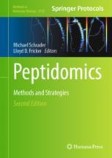Search
Search Results
-
An Updated Guide to the Identification, Quantitation, and Imaging of the Crustacean Neuropeptidome
Crustaceans serve as a useful, simplified model for studying peptides and neuromodulation, as they contain numerous neuropeptide homologs to mammals...
-
Histamine and gamma-aminobutyric acid in the nervous system of Pygospio elegans (Annelida: Spionidae): structure and recovery during reparative regeneration
BackgroundIn recent two decades, studies of the annelid nervous systems were revolutionized by modern cell labeling techniques and state-of-the-art...

-
May the palps be with you – new insights into the evolutionary origin of anterior appendages in Terebelliformia (Annelida)
BackgroundHead appendages in Annelida contribute significantly to the immense morphological diversity in this spiralian taxon. Nevertheless, the...

-
Within-family plasticity of nervous system architecture in Syllidae (Annelida, Errantia)
BackgroundThe ground pattern underlying the nervous system of the last common ancestor in annelids was long thought to be settled, consisting of a...

-
Loss of complexity from larval towards adult nervous systems in Chaetopteridae (Chaetopteriformia, Annelida) unveils evolutionary patterns in Annelida
Chaetopteridae — the parchment worms — comprise a group of early branching annelids with a scarcely investigated neuroanatomy and neurogenesis. Due...

-
Morphology, Anatomy, and Physiological Aspects of Dytiscids
Although the morphology of dytiscids is generally distinct from other aquatic insects, there is considerable variation within this highly diverse...
-
Anatomy of the Nervous System of Triatomines
The nervous system of triatomines follows the general plan for insects in terms of organization. Yet, its anatomy is in line with the form of the...
-
Morphology of the nervous system of monogonont rotifer Epiphanes senta with a focus on sexual dimorphism between feeding females and dwarf males
BackgroundMonogononta is a large clade of rotifers comprised of diverse morphological forms found in a wide range of ecological habitats. Most...

-
Localizing the Puke Button of Grasshoppers: Tactile Stimulation of Different Body Regions Influences the Regurgitation Response of Schistocerca Serialis Cubense (Orthoptera)
Regurgitation behavior is a defense strategy present in several insect orders where herbivorous prey may acquire secondary noxious metabolites from...

-
Chemical cognition: chemoconnectomics and convergent evolution of integrative systems in animals
Neurons underpin cognition in animals. However, the roots of animal cognition are elusive from both mechanistic and evolutionary standpoints. Two...

-
Molecular and morphological analysis of the develo** nemertean brain indicates convergent evolution of complex brains in Spiralia
BackgroundThe brain anatomy in the clade Spiralia can vary from simple, commissural brains (e.g., gastrotrichs, rotifers) to rather complex,...

-
A perspective on neuroethology: what the past teaches us about the future of neuroethology
For 100 years, the Journal of Comparative Physiology-A has significantly supported research in the field of neuroethology. The celebration of the...

-
Sensory systems of Lineus ruber (Nemertea, Pilidiophora)
The aim of this study was to examine the organization of sensory systems in the heteronemertean Lineus ruber (Müller, 1774). Sensory systems of the...

-
The transient potassium outward current has different roles in modulating the pyloric and gastric mill rhythms in the stomatogastric ganglion
The crustacean stomatogastric nervous system is a classic model for understanding the effects of modulating ionic currents and synapses at both the...

-
Can the native crab Thalamita danae be an effective biological control agent of the invasive mussel Xenostrobus securis in Hong Kong?
Local predators are often considered effective and environmentally-friendly control agents to limit invasive species. Such biological control,...

-
Biogenic Monoamines in the Control of Triatomine Physiology with Emphasis on Rhodnius prolixus
The biogenic monoamines, serotonin, octopamine, tyramine, dopamine and histamine are present within insect nervous systems, where they modulate...
-
Cholecystokinin/sulfakinin peptide signaling: conserved roles at the intersection between feeding, mating and aggression
Neuropeptides are the most diverse messenger molecules in metazoans and are involved in regulation of daily physiology and a wide array of behaviors....

-
One hundred years of excellence: the top one hundred authors of the Journal of Comparative Physiology A
The Journal of Comparative Physiology A is the premier peer-reviewed scientific journal in comparative physiology, in particular sensory physiology,...

-
The anatomy and development of the nervous system in Magelonidae (Annelida) – insights into the evolution of the annelid brain
BackgroundThe annelid anterior central nervous system is often described to consist of a dorsal prostomial brain, consisting of several commissures...

-
Feedforward discharges couple the singing central pattern generator and ventilation central pattern generator in the cricket abdominal central nervous system
We investigated the central nervous coordination between singing motor activity and abdominal ventilatory pum** in crickets. Fictive singing, with...

